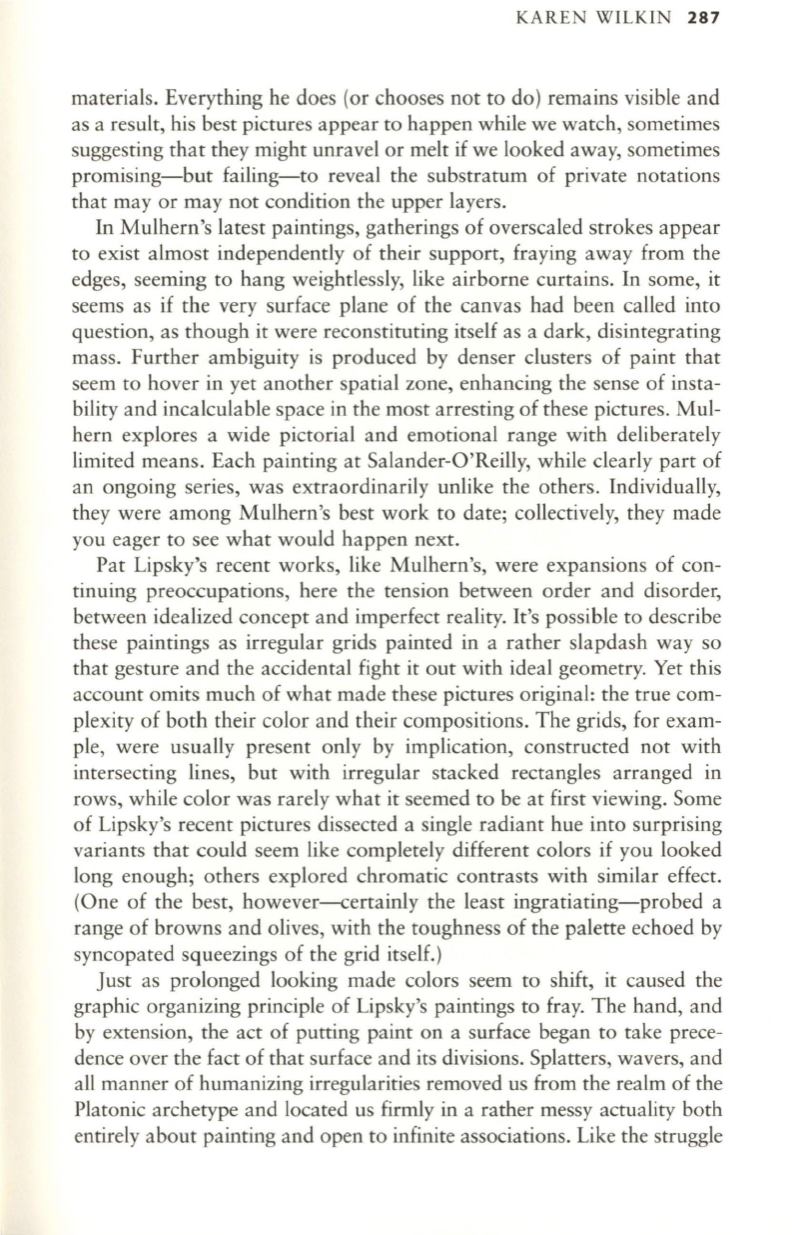
KAREN WILKIN
287
materials. Everything he does (or chooses not to do) remains visible and
as a result, his best pictures appear to happen while we watch, sometimes
suggesting that they might unrave l or melt if we looked away, sometimes
promising- but failing-to reveal the substratum of private notations
that mayor may not condition the upper layers.
In Mulhern's latest paintings, gatherings of overscaled strokes appear
to exist almost independently of their support, fraying away from the
edges, seeming to hang weightlessly, like airborne curtains. In some, it
seems as if the very surface plane of the canvas had been called into
question, as though it were reconstituting itself as a dark, disintegrating
mass. Further ambiguity is produced by denser clusters of paint that
seem to hover in yet another spatial zone, enhancing the sense of insta–
bility and incalculable space in the most arresting of these pictures. Mul–
hern explores a wide pictorial and emotional range with deliberately
limited means. Each painting at Salander-O'Reilly, while clearly part of
an ongoing series, was extraordinarily unlike the others . Individually,
they were among Mulhern's best work to date; collectively, they made
you eager to see what would happen next.
Pat Lipsky's recent works, like Mulhern'S, were expansions of con–
tinuing preoccupations, here the tension between order and disorder,
between idealized concept and imperfect reality. It's possible to describe
these paintings as irregular grids painted in a rather slapdash way so
that gesture and the accidental fight it out with ideal geometry. Yet this
account omits much of what made these pictures original: the true com–
plexity of both their color and their compositions. The grids, for exam–
ple, were usually present only by implication, constructed not with
intersecting lines, but with irregular stacked rectangles arranged in
rows, while color was rarely what it seemed to be at first viewing. Some
of Lipsky's recent pictures dissected a single radiant hue into surprising
variants that could seem like completely different colors if you looked
long enough; others explored chromatic contrasts with similar effect.
(One of the best, however---certainly the least ingratiating-probed a
range of browns and olives, with the toughness of the palette echoed by
syncopated squeezings of the grid itself.)
Just as prolonged looking made colors seem to shift, it caused the
graphic organizing principle of Lipsky's paintings to fray. The hand, and
by extension, the act of putting paint on a surface began to take prece–
dence over the fact of that surface and its divisions. Splatters, wavers, and
all manner of humanizing irregularities removed us from the realm of the
Platonic archetype and located us firmly in a rather messy actuality both
entirely about painting and open to infinite associations. Like the struggle


